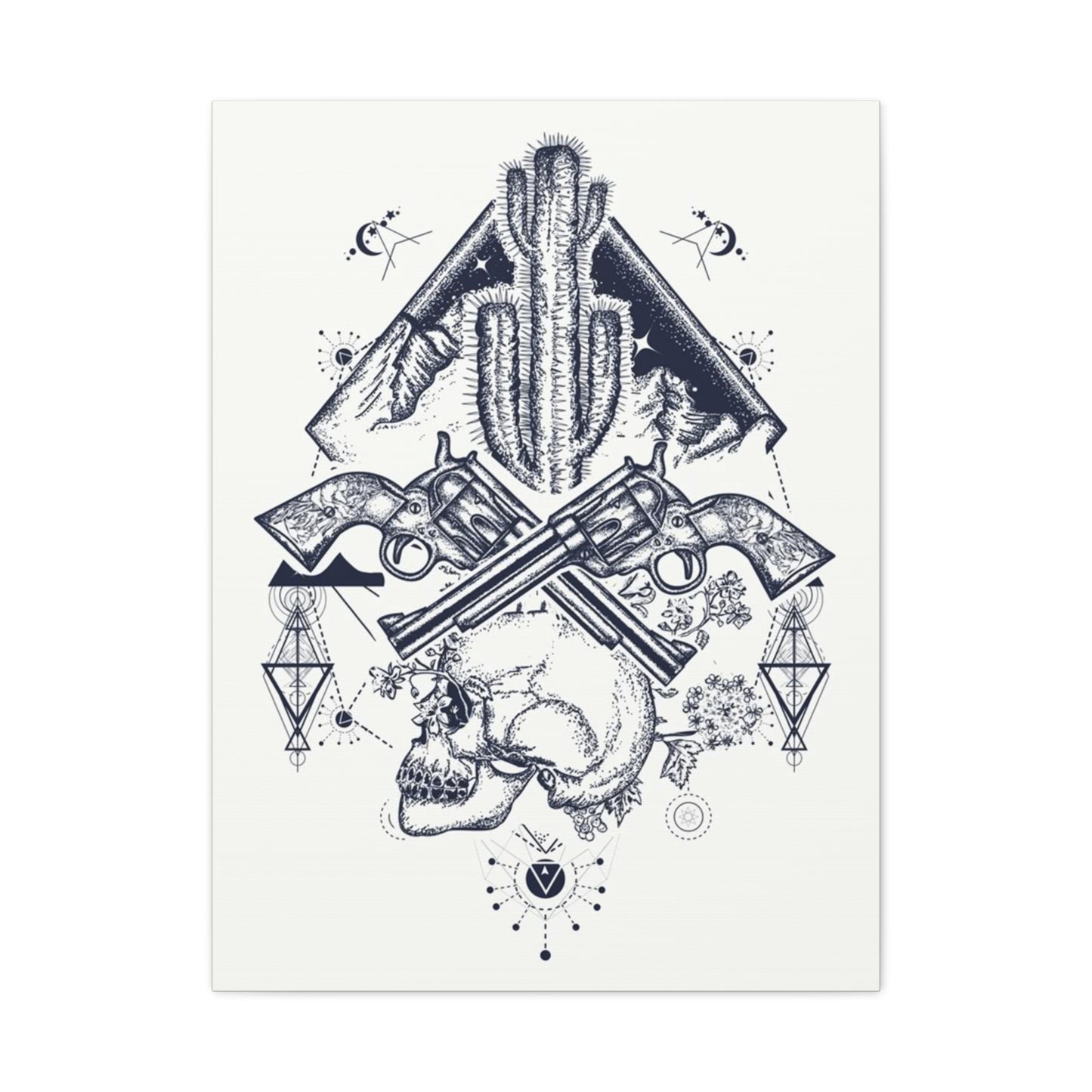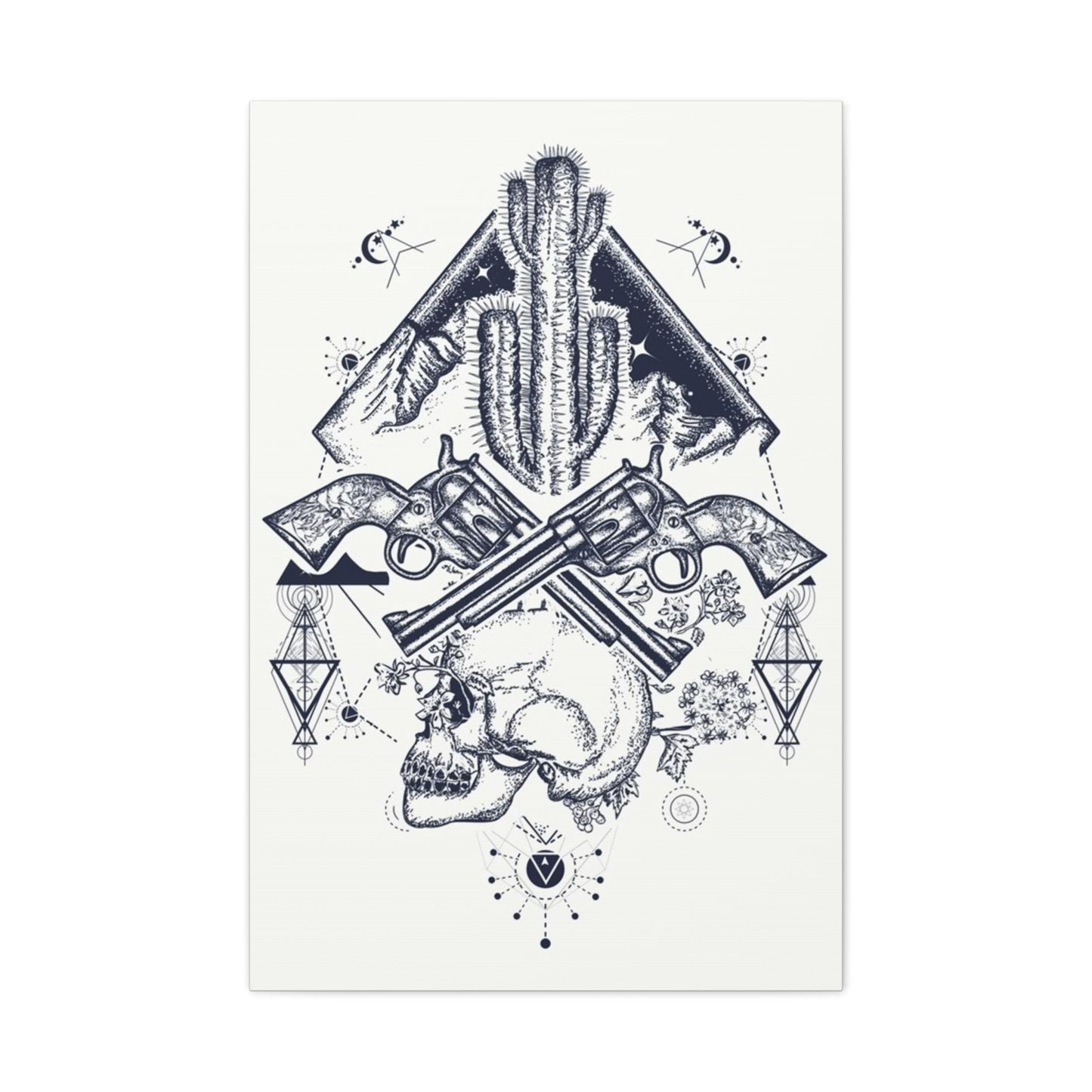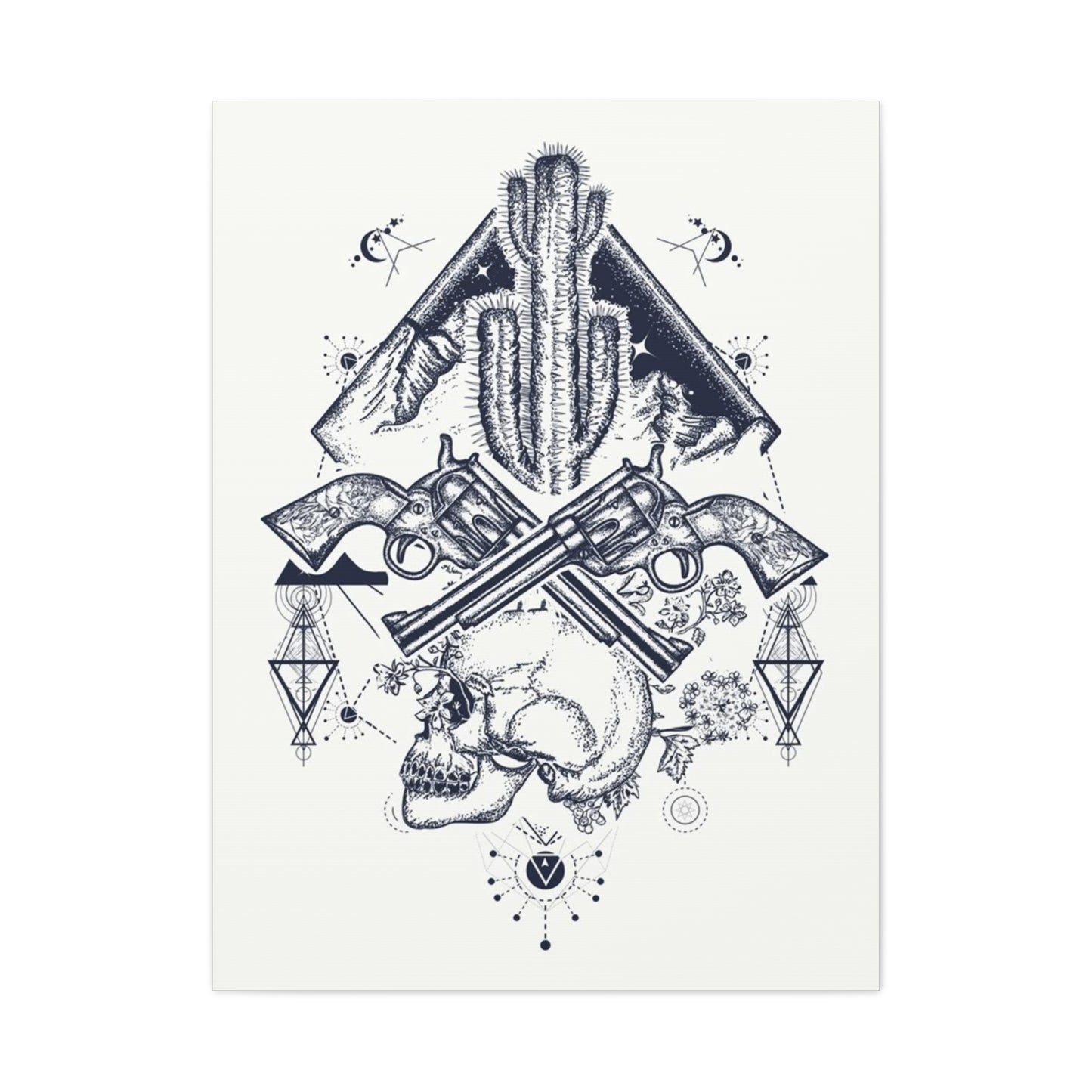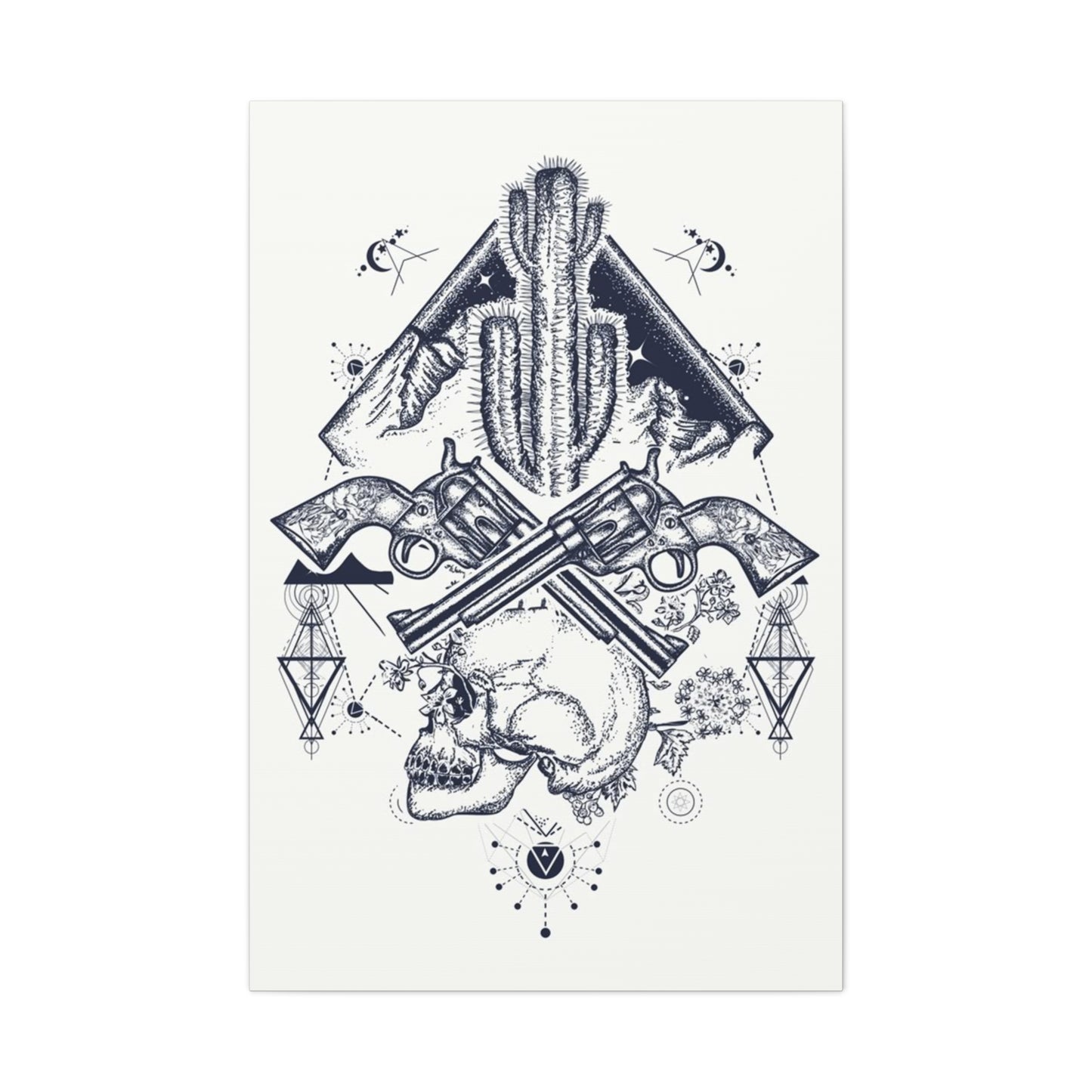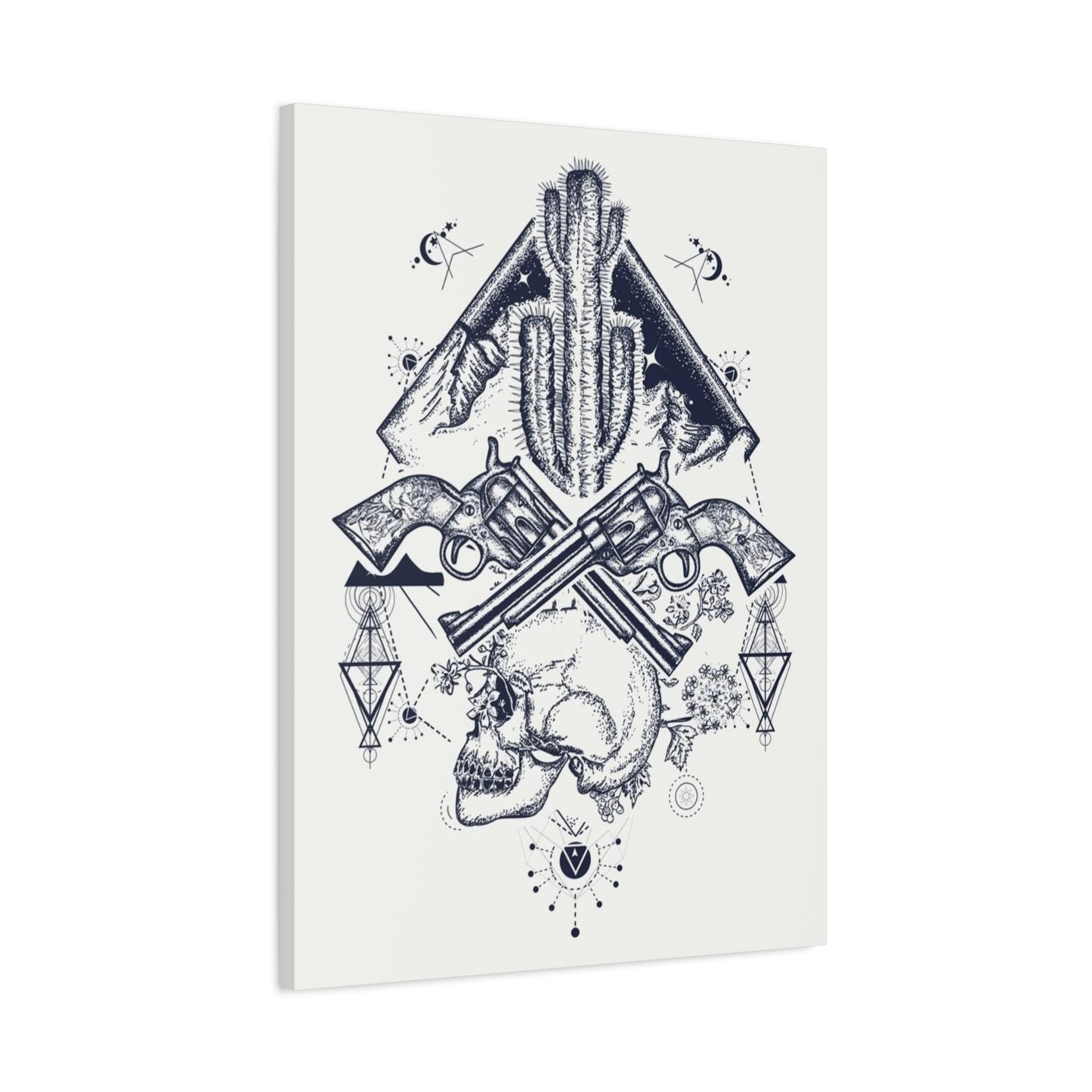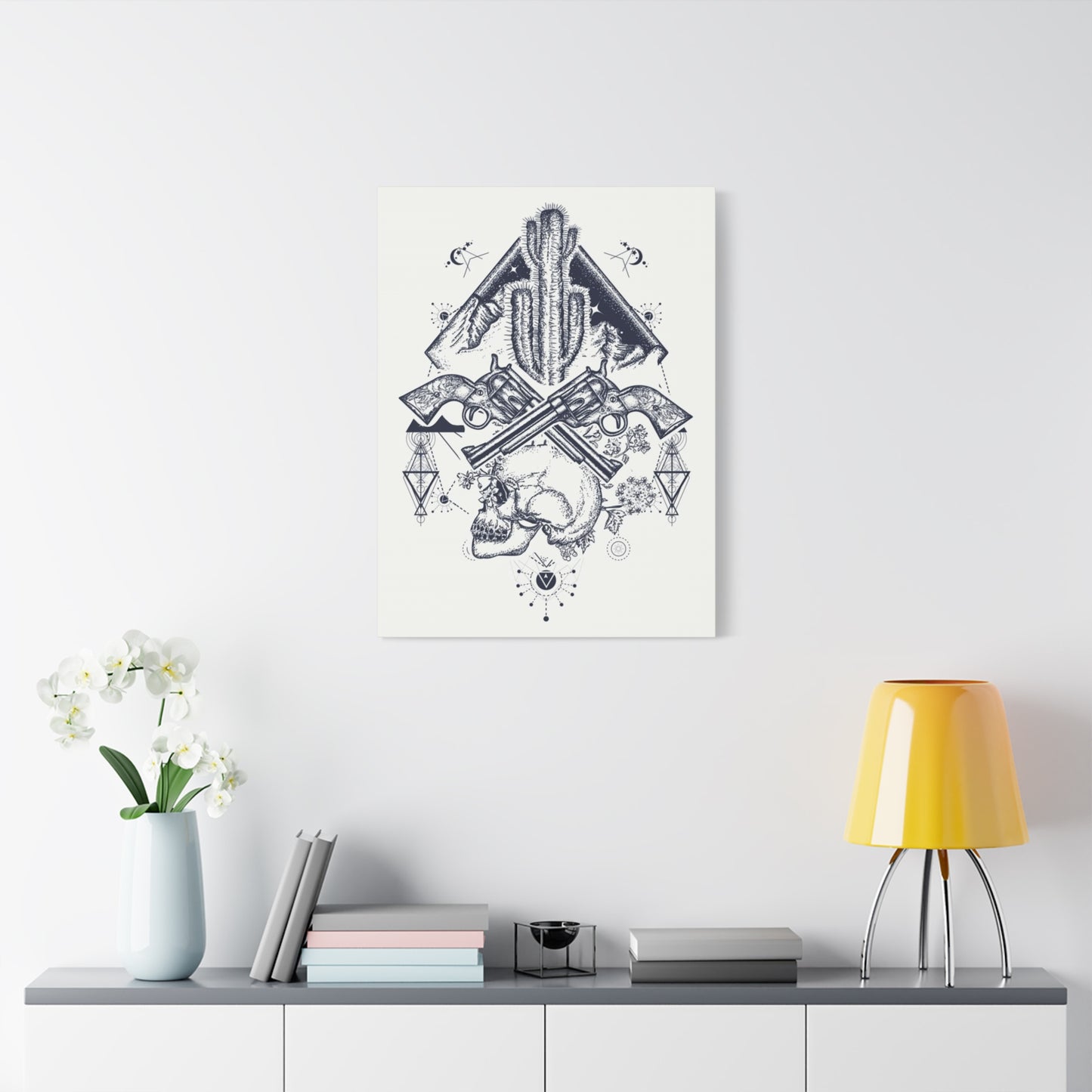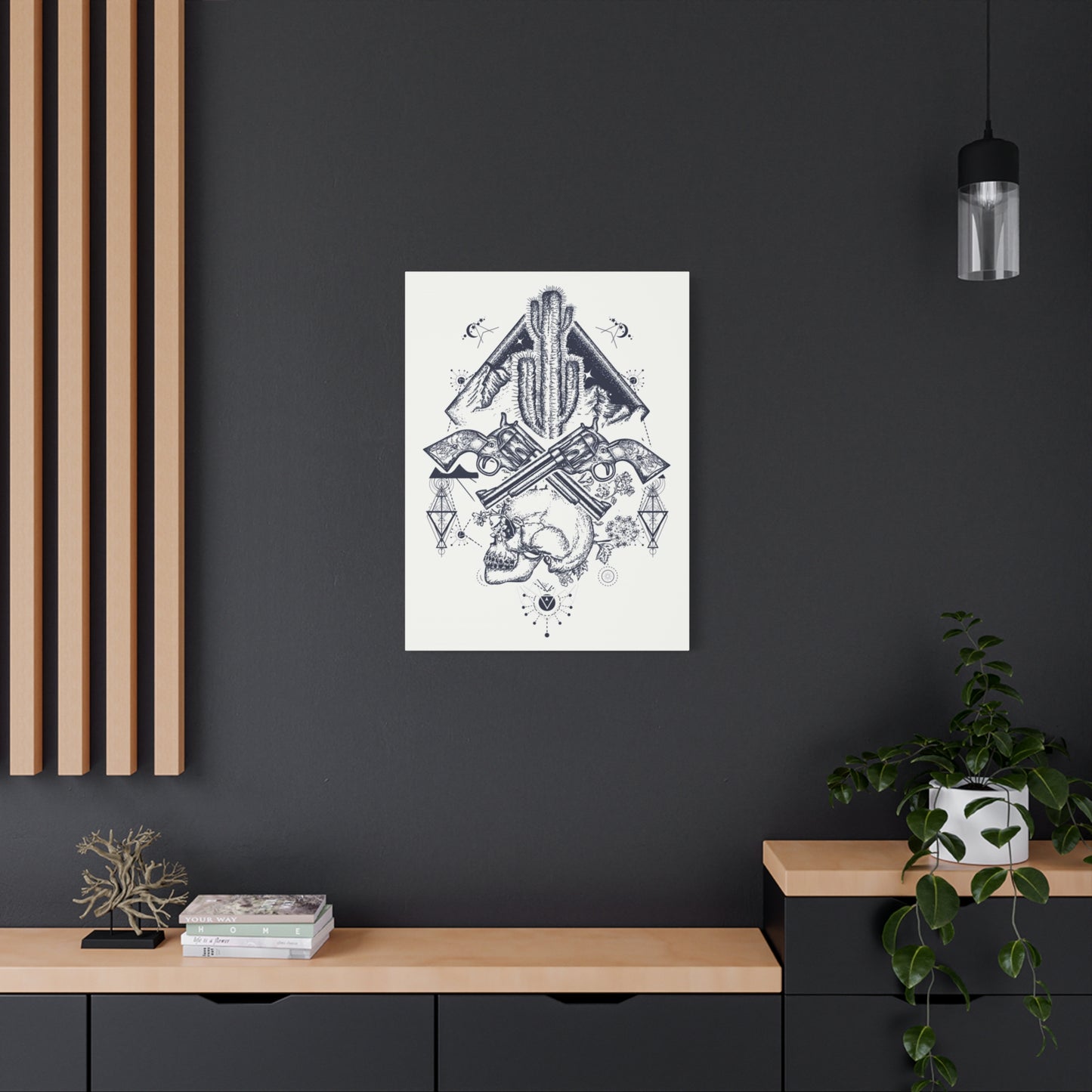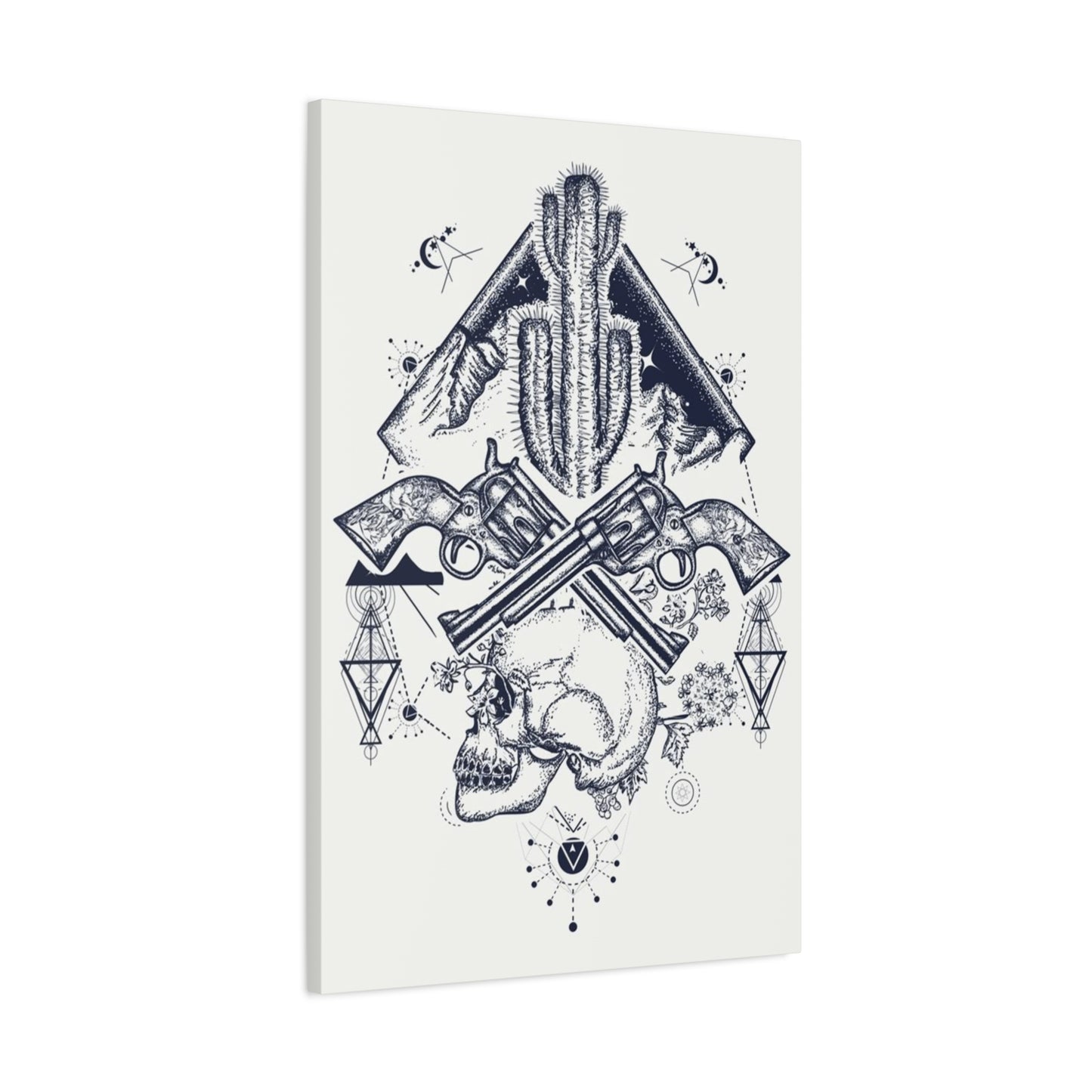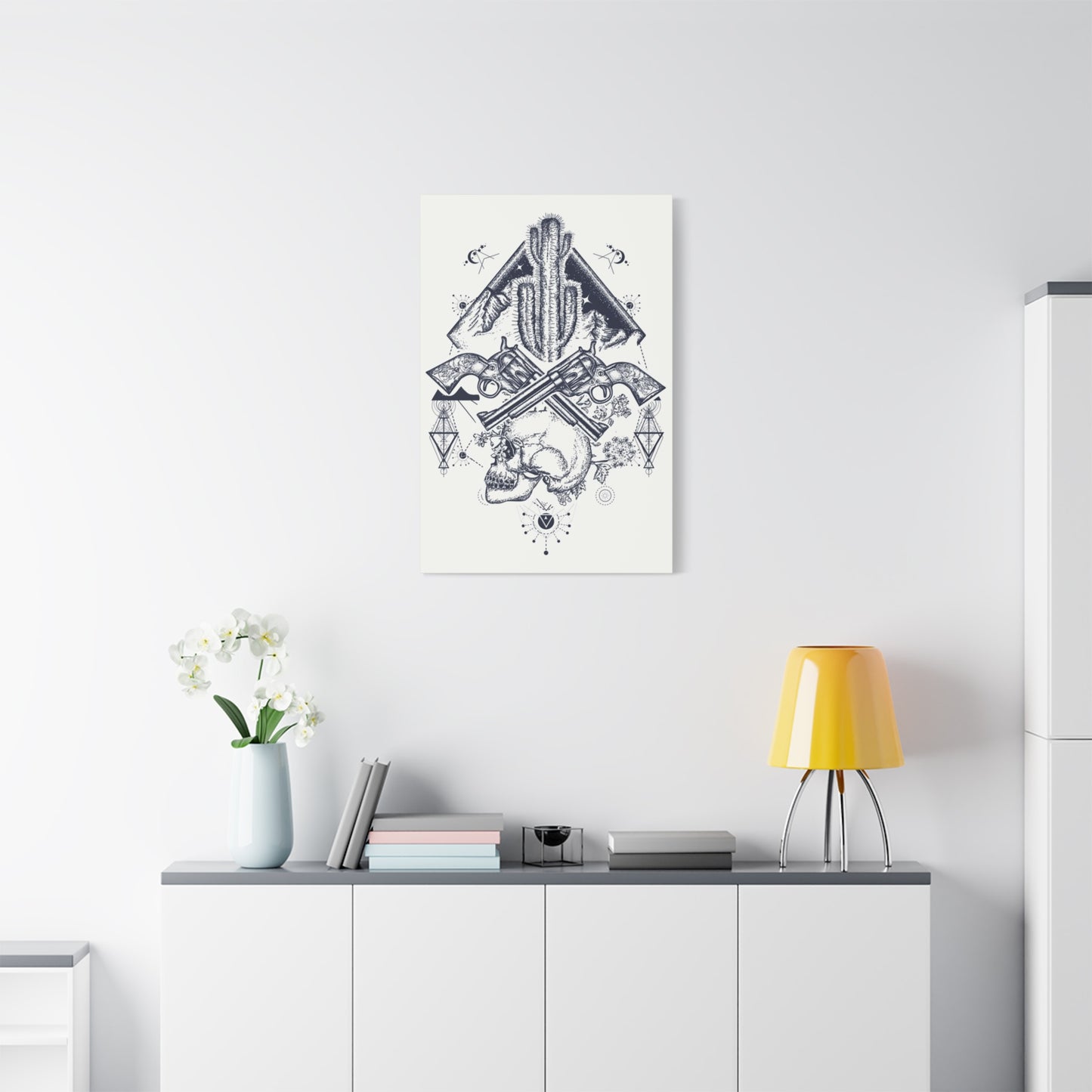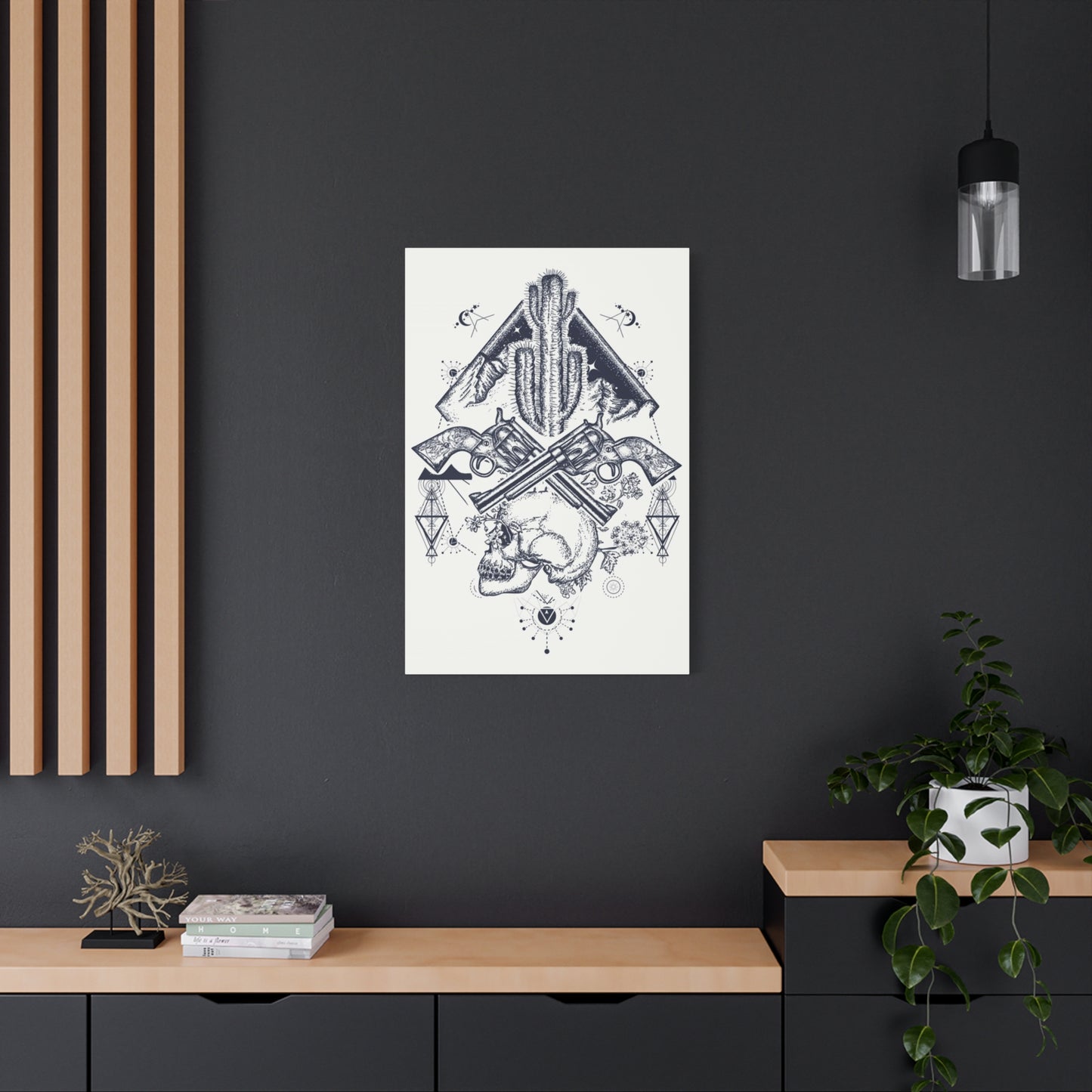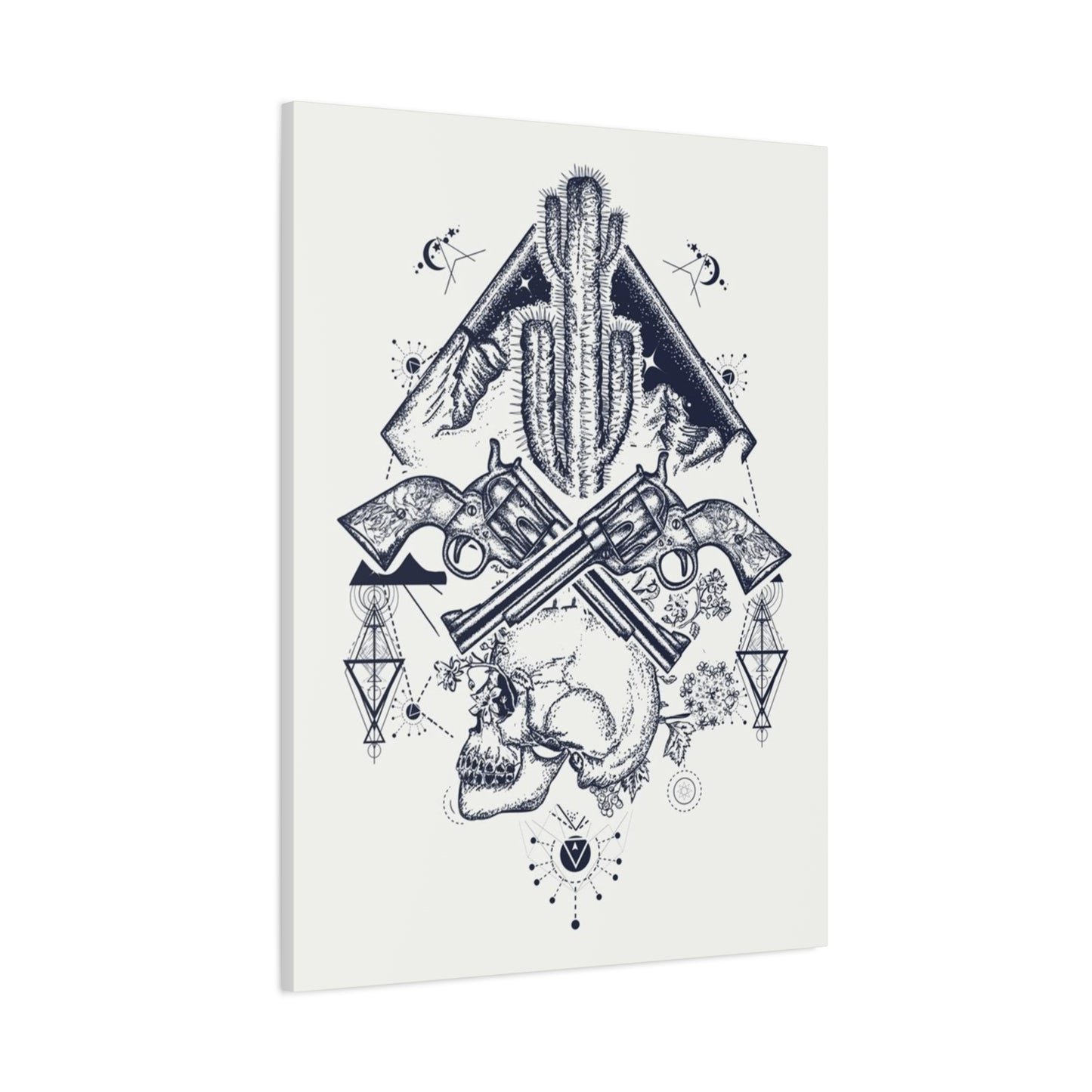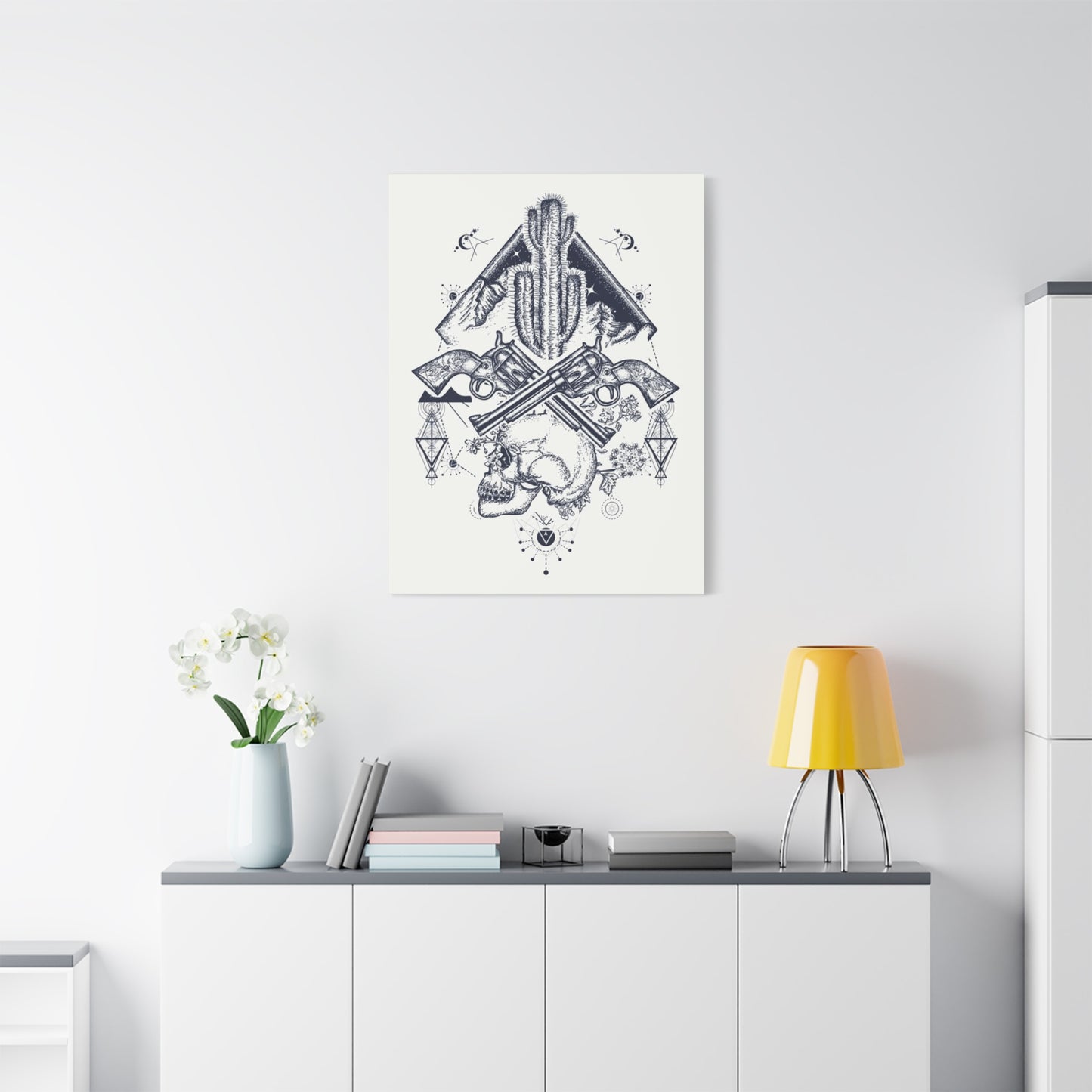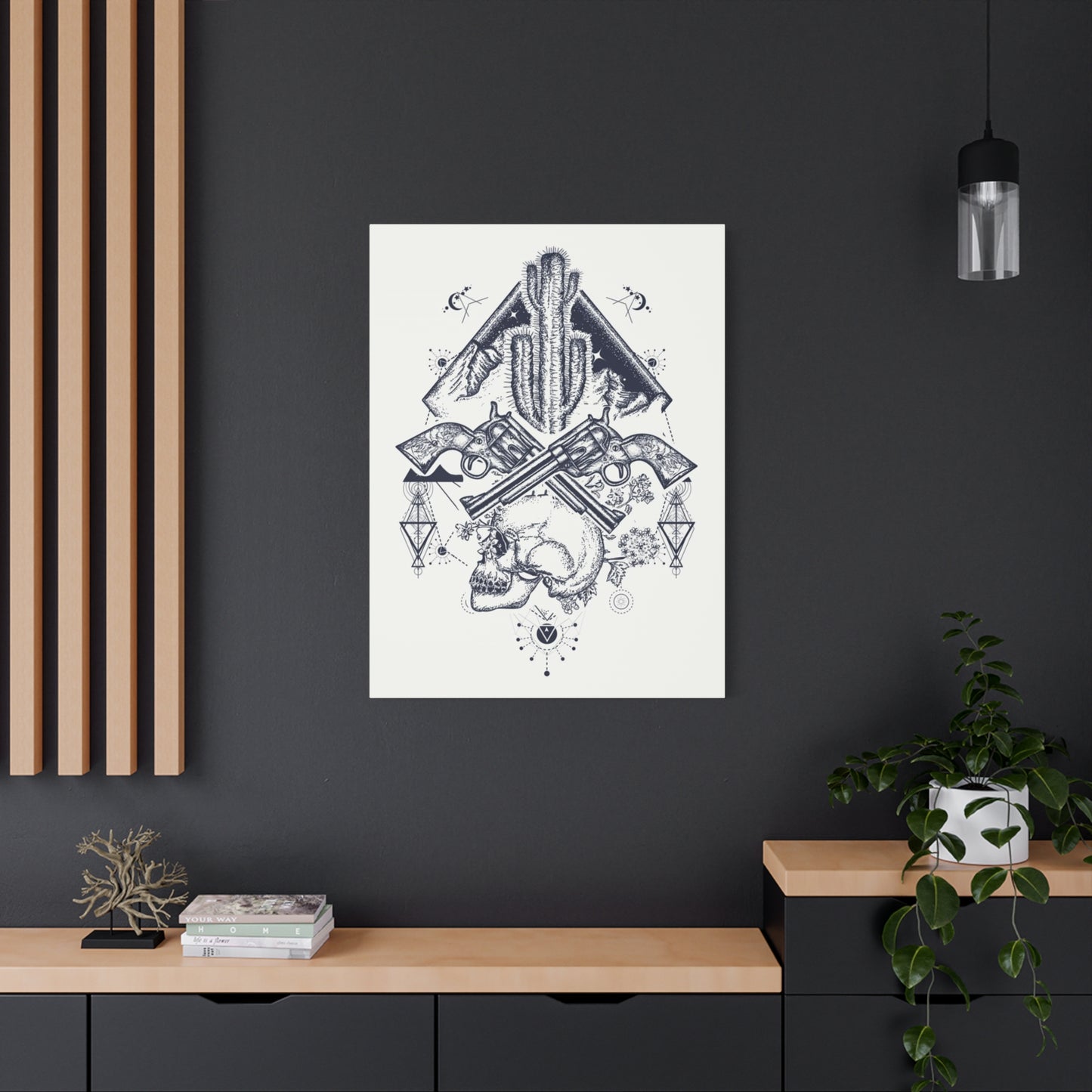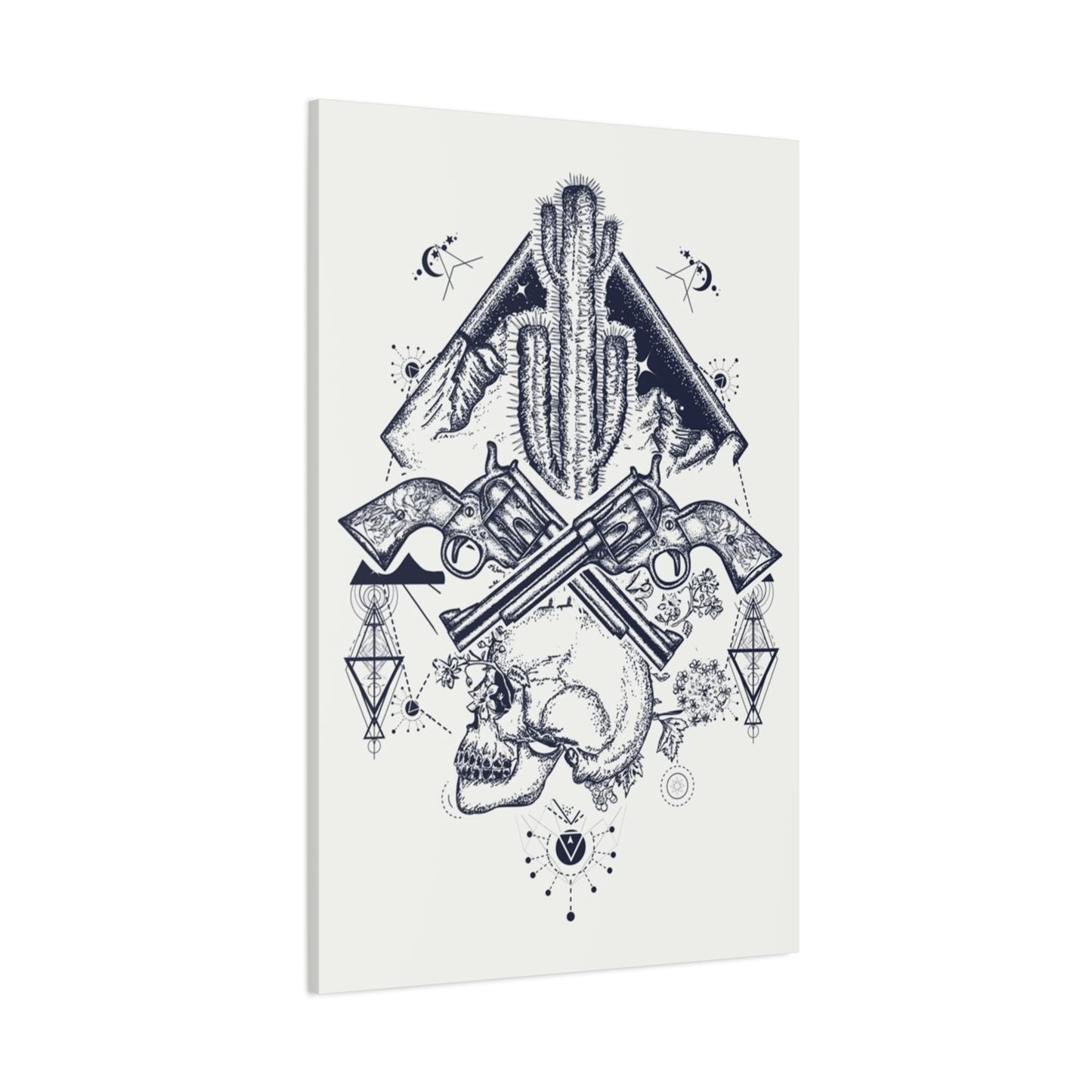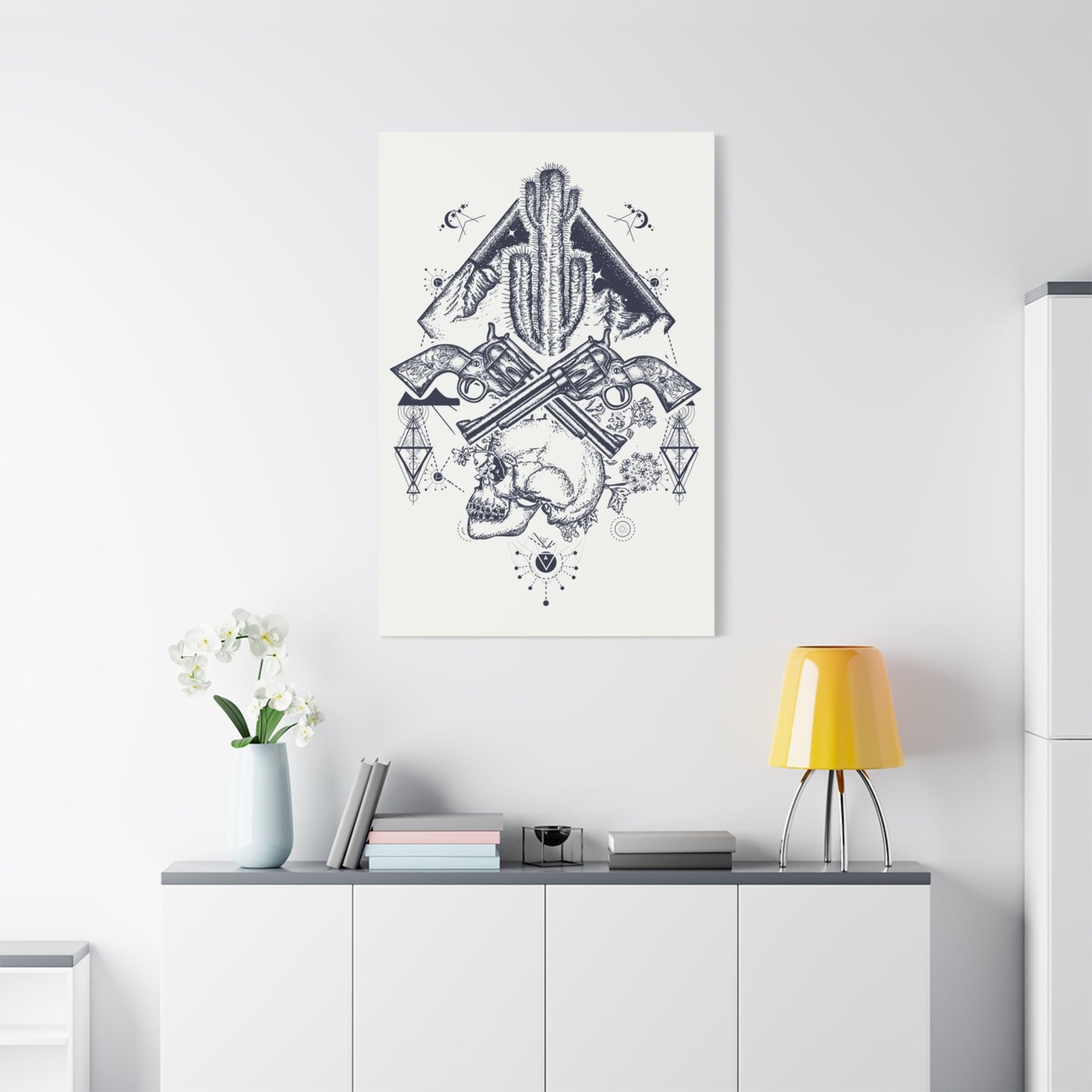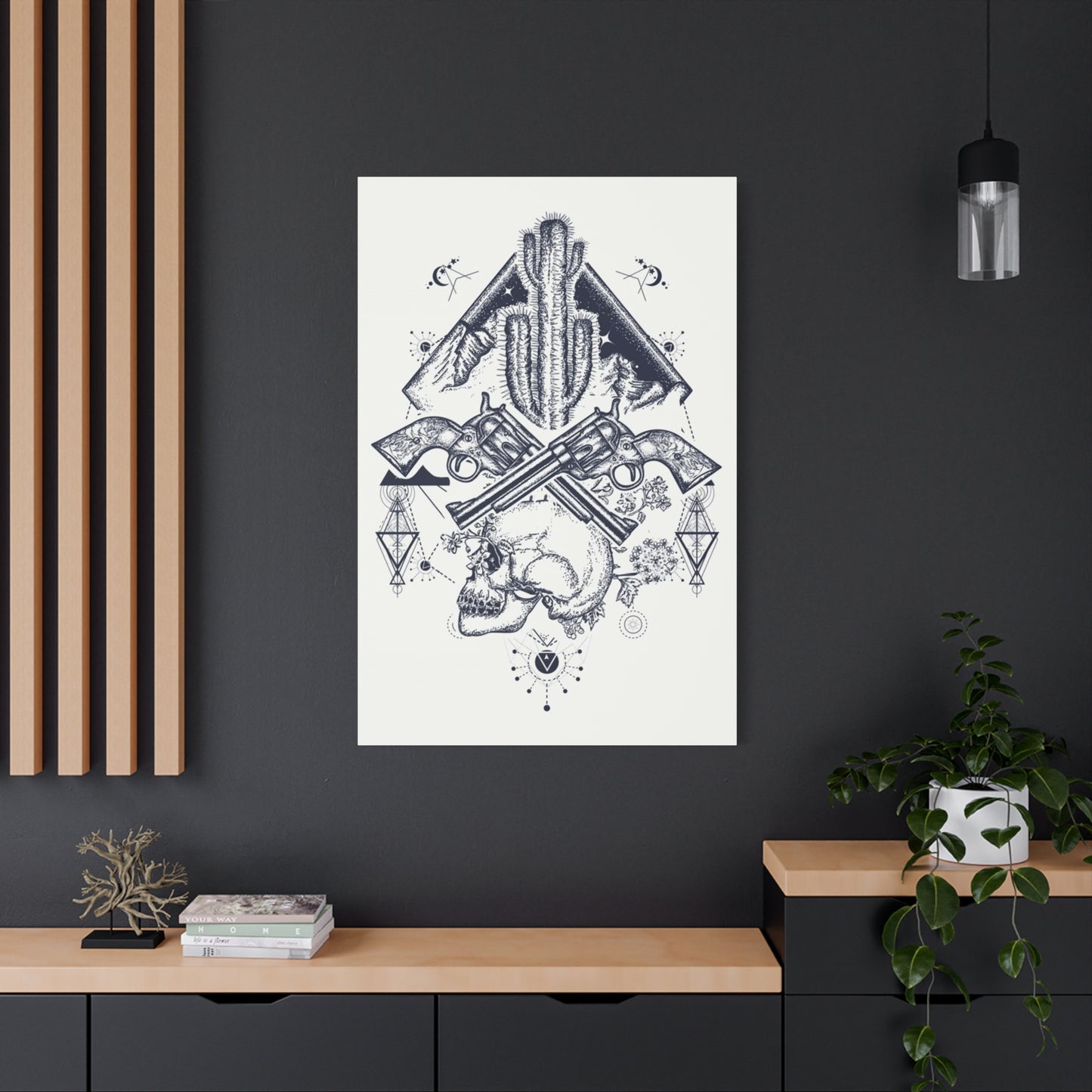Western Gothic Guns Cactus Skull Wall Art: Mastering Bold Sketches and Dramatic Visual Statements
The fusion of Western themes with gothic elements has emerged as one of the most compelling artistic movements in contemporary home decoration. This unique aesthetic combines the rugged beauty of desert landscapes with the mysterious allure of darker imagery, creating powerful visual narratives that speak to both adventure seekers and those drawn to unconventional artistic expressions.
The appeal of guns, cacti, and skull motifs in artistic compositions stems from their rich symbolic heritage and striking visual impact. These elements represent different aspects of the American frontier experience while simultaneously tapping into universal themes of mortality, survival, and the relationship between civilization and wilderness. When skillfully combined in sketches and artwork, they create compositions that are both visually arresting and emotionally provocative.
Modern artists and homeowners alike are discovering the power of these motifs to transform ordinary living environments into extraordinary statements of personal style. The combination of sharp, angular gun silhouettes with the organic curves of desert plants and the haunting presence of skull imagery creates a visual tension that demands attention while maintaining artistic sophistication.
This artistic approach transcends simple decoration, offering a means of expressing complex themes about life, death, danger, and natural beauty. The interplay between these seemingly disparate elements creates opportunities for deep artistic exploration and meaningful personal expression through carefully curated visual displays.
Merging Cactus and Skull Elements in Artistic Compositions
The artistic marriage of cactus and skull imagery represents one of the most intriguing developments in contemporary sketch art. This combination draws upon the rich symbolism inherent in both elements, creating compositions that speak to themes of resilience, mortality, and the harsh beauty of desert environments. The organic, life-affirming presence of cacti provides a compelling counterpoint to the memento mori symbolism of skulls, resulting in artwork that explores the cyclical nature of existence.
When creating sketches that incorporate both cactus and skull motifs, artists often explore the visual parallels between these elements. The geometric patterns found in cactus structures echo the architectural qualities of skull formations, while the spines and protective mechanisms of desert plants mirror the defensive imagery often associated with mortality symbols. This natural affinity between the forms makes their combination feel organic rather than forced, creating harmonious compositions that feel both surprising and inevitable.
The textural contrasts available when combining these elements offer rich opportunities for artistic exploration. Cactus imagery provides opportunities to explore various line weights and shading techniques, from the smooth, curved surfaces of barrel cacti to the intricate spine patterns of smaller desert plants. Skull imagery, meanwhile, offers dramatic opportunities for shadow work and the exploration of negative space, creating focal points that draw the viewer deeper into the composition.
Successful combinations often employ cacti as framing elements around skull imagery, creating natural borders that contain and focus the more dramatic elements. Alternatively, skulls can be integrated into cactus gardens, suggesting themes of hidden danger or the persistence of life in harsh environments. These compositional choices allow artists to create narratives within their work that speak to broader themes about survival, adaptation, and the relationship between life and death.
The symbolic resonance of this combination extends beyond mere visual appeal. Cacti represent endurance, protection, and the ability to thrive in challenging conditions, while skulls symbolize mortality, wisdom gained through experience, and the acceptance of life's finite nature. When combined, these symbols create a powerful meditation on the human condition and our relationship with both the natural world and our own mortality.
Color choices play a crucial role in the success of cactus and skull combinations. Monochromatic approaches using various shades of black, white, and gray create dramatic, timeless pieces that emphasize form and composition over decorative elements. Alternatively, limited color palettes incorporating earth tones can ground the imagery in desert environments while maintaining the mysterious qualities that make these combinations so compelling.
The scale relationships between cactus and skull elements require careful consideration to maintain visual balance. Oversized skull imagery paired with delicate cactus details creates a sense of drama and proportion that can dominate a composition, while smaller skulls nestled among larger cactus forms create more intimate, discovery-oriented viewing experiences. These scale choices directly impact the emotional tone of the finished artwork.
Cultural considerations also play an important role in these artistic combinations. Both cacti and skulls carry significant meaning in various cultural contexts, from Mexican Day of the Dead traditions to Native American desert spirituality. Respectful incorporation of these cultural elements can add depth and authenticity to artistic works while avoiding appropriation through careful research and sensitive artistic choices.
The technical execution of cactus and skull combinations requires mastery of different drawing techniques within a single composition. Cactus rendering often benefits from precise line work and careful attention to botanical accuracy, while skull imagery allows for more expressive, atmospheric approaches. Balancing these different technical requirements while maintaining compositional unity challenges artists to expand their technical repertoire.
Contemporary applications of this artistic combination extend beyond traditional drawing and painting into digital media, sculpture, and mixed-media installations. The strong graphic qualities of both cactus and skull imagery translate well across different media, making these combinations versatile choices for artists working in various disciplines and scales.
Bold Firearms and Desert Plant Artwork for Rustic Aesthetics
The integration of firearm imagery with desert plant motifs creates a powerful aesthetic that speaks to the rugged individualism and frontier spirit of Western culture. This artistic approach combines the mechanical precision of weaponry with the organic beauty of desert flora, resulting in compositions that celebrate both human craftsmanship and natural resilience. The contrast between manufactured and natural forms creates visual tension that energizes these artistic combinations.
Firearm imagery in artistic contexts carries complex symbolic weight, representing protection, power, craftsmanship, and historical significance. When paired with desert plants like cacti, agaves, and desert roses, these symbols take on additional layers of meaning related to survival, adaptation, and the taming of harsh environments. The resulting artwork speaks to themes of self-reliance and the relationship between civilization and wilderness.
The visual characteristics of firearms provide excellent opportunities for detailed technical drawing and precise line work. The mechanical components, textures, and proportions of different weapon types offer artists chances to demonstrate technical skill while creating focal points that command attention. The angular, geometric qualities of firearm designs create strong compositional anchors around which softer, more organic desert plant imagery can flow.
Desert plants bring balance to firearm-dominated compositions through their curved forms, varied textures, and growth patterns that soften the harder edges of mechanical imagery. The spines, flowers, and structural elements of desert plants provide opportunities for contrast in both texture and symbolic meaning, creating compositions that explore themes of beauty and danger, cultivation and wilderness, protection and nurture.
Color palettes for these combinations often draw from the muted tones of desert environments, incorporating sandy beiges, sage greens, rust oranges, and deep browns that ground the imagery in specific geographic and cultural contexts. These earth-tone palettes create cohesion between disparate elements while maintaining the rustic aesthetic that makes these combinations so appealing for Western-themed decoration.
The historical context of firearms in Western expansion provides rich background for these artistic combinations. The tools that enabled settlement of harsh desert regions are paired with the plants that characterized those same environments, creating artwork that tells stories about human adaptation and survival. This historical resonance adds depth to purely decorative applications while maintaining respect for the cultural significance of both elements.
Compositional strategies for combining firearms and desert plants vary widely depending on the intended impact and setting. Firearms can serve as vertical elements that provide structure for flowing plant forms, or they can be integrated into plant arrangements as discovered objects that suggest stories of abandonment or hidden danger. These compositional choices directly impact the narrative quality of the finished work.
The rustic aesthetic associated with these combinations extends beyond the imagery itself to include considerations of materials, presentation, and setting. Artwork incorporating these motifs often benefits from presentation methods that emphasize handcraft and natural materials, such as reclaimed wood frames, canvas textures, or paper choices that complement the rugged themes of the imagery.
Technical execution of firearm and desert plant combinations requires attention to accuracy in both mechanical and botanical details. Proper proportions, realistic textures, and authentic details in both categories enhance the credibility and impact of the artwork while demonstrating respect for the subjects being portrayed. This attention to accuracy also helps avoid cartoonish or disrespectful treatment of serious subjects.
The audience for firearm and desert plant artwork includes collectors of Western art, outdoor enthusiasts, and those seeking to create distinctive home environments that reflect personal values and interests. This specific audience appreciates authenticity, craftsmanship, and symbolic depth in their artistic choices, making technical excellence and conceptual sophistication essential elements of successful work in this category.
Contemporary applications of these artistic combinations extend into various media and formats, from traditional oil paintings and charcoal drawings to digital prints and large-scale murals. The strong graphic qualities of both firearms and desert plants translate effectively across different scales and media, making these combinations versatile choices for various artistic and commercial applications.
Deeper Meanings of Death Imagery and Desert Flora in Visual Arts
The symbolic relationship between death imagery and desert flora in visual arts reveals profound connections between mortality and survival, creating artwork that explores fundamental questions about existence, endurance, and the cycles of life. This artistic exploration draws upon universal human experiences while tapping into specific cultural and environmental contexts that give these symbols their particular power and resonance.
Death imagery in art has served various functions throughout human history, from memento mori reminders of mortality to celebrations of life's preciousness in the face of inevitable endings. When combined with desert flora, these symbols take on additional meanings related to the harsh beauty of environments where survival requires extraordinary adaptation and resilience. The result is artwork that speaks to both individual mortality and the broader themes of life persisting in challenging conditions.
Desert plants embody survival strategies that have evolved over millions of years, representing nature's ability to find life in the most challenging circumstances. Their presence in death-themed artwork creates a counterpoint that suggests hope, continuity, and the persistence of life even in the face of harsh realities. This symbolic tension between endings and continuance creates rich material for artistic exploration and personal meditation.
The visual characteristics of skulls and bones provide artists with opportunities to explore form, shadow, and negative space in ways that create dramatic focal points and emotional impact. These forms have been refined by evolution and cultural use into instantly recognizable symbols that carry immediate emotional weight, making them powerful tools for artistic communication across cultural and linguistic boundaries.
Desert flora offers contrasting symbolic content that speaks to resilience, adaptation, and hidden beauty. The ability of cacti and other desert plants to store water, protect themselves, and bloom in harsh conditions provides metaphorical material that enriches death-themed artwork with suggestions of hope and persistence. This symbolic richness allows artists to create works that acknowledge mortality while celebrating life's tenacity.
Color symbolism plays a crucial role in the interpretation of death imagery and desert flora combinations. Traditional associations of black and white with death can be modified and enriched through the introduction of desert colors like sage green, rust red, and golden yellow, creating artwork that maintains serious thematic content while avoiding overly morbid or depressing visual impact.
Cultural contexts significantly influence the interpretation of death and desert plant imagery. Mexican artistic traditions, for example, incorporate skull imagery into celebrations of life and memory, while Native American traditions often view desert plants as sacred beings with their own spiritual significance. Understanding and respecting these cultural contexts adds authenticity and depth to artistic works while avoiding inappropriate appropriation.
The technical challenges of combining death imagery with desert flora require artists to balance different types of form and texture within unified compositions. Skull imagery often benefits from smooth gradations and careful attention to three-dimensional form, while desert plants require different approaches to texture and surface treatment. Successfully combining these different technical requirements demonstrates artistic skill while creating visually compelling results.
Philosophical implications of death and desert plant combinations extend beyond mere decoration into meditation on fundamental questions about existence, meaning, and the relationship between individual lives and larger natural cycles. This philosophical depth makes these artistic combinations particularly suitable for personal reflection and meaningful gift-giving, as they offer viewers opportunities for contemplation beyond simple aesthetic pleasure.
Contemporary applications of these symbolic combinations extend into various artistic media and commercial applications, from gallery artwork to therapeutic art practices where the themes of mortality and resilience provide material for personal exploration and healing. The universal nature of these themes ensures continued relevance across cultural and generational boundaries.
The psychological impact of death imagery paired with life-affirming desert plants creates artwork that can serve various emotional needs, from helping viewers process grief and loss to celebrating the strength required to survive difficult circumstances. This emotional versatility makes these artistic combinations valuable tools for both artists and viewers seeking meaningful visual experiences.
Monochrome Illustrations of Weaponry and Death Symbols
Monochrome artistic approaches to weaponry and death symbols create powerful visual statements that emphasize form, composition, and symbolic content over decorative color elements. This artistic strategy allows artists to focus viewer attention on the essential qualities of these potent symbols while creating timeless pieces that transcend temporary color trends and style preferences.
The absence of color in monochrome illustrations forces viewers to engage with the pure forms and compositional relationships within the artwork, creating more direct emotional and intellectual responses to the symbolic content. This directness makes monochrome treatments particularly effective for serious subject matter where the goal is contemplation rather than decoration, allowing the inherent power of the symbols to speak without distraction.
Technical execution of monochrome weaponry and death symbol illustrations requires mastery of value relationships, contrast management, and texture creation using only gradations of a single color. These technical challenges push artists to develop sophisticated understanding of light, shadow, and form while creating artwork that demonstrates clear artistic skill and intention.
Weaponry illustrations in monochrome formats benefit from the graphic nature of mechanical forms, which translate effectively into high-contrast treatments that emphasize the precision and craftsmanship of these objects. The clean lines and geometric relationships inherent in weapon design create natural opportunities for dramatic lighting effects and bold compositional statements that work particularly well in black and white formats.
Death symbols like skulls and bones possess inherent drama that is enhanced rather than diminished by monochrome treatment. The archetypal nature of these forms means that they retain their symbolic power even when stripped of color, while the absence of color allows viewers to focus on the universal rather than specific cultural associations these symbols might carry.
Contrast relationships in monochrome illustrations become crucial elements of both composition and meaning. High contrast between light and dark areas can create dramatic, confrontational effects that emphasize the serious nature of the subject matter, while subtle gradations can create more contemplative, meditative responses that encourage quiet reflection rather than immediate emotional reaction.
Texture creation in monochrome weaponry and death symbol illustrations requires sophisticated understanding of how different mark-making techniques can suggest various surface qualities without the aid of color cues. Cross-hatching, stippling, and various shading techniques become essential tools for creating visual interest and realistic surface treatment within the limitations of single-color palettes.
The historical precedent for monochrome treatment of serious subjects extends back centuries in artistic traditions worldwide, from medieval manuscripts to Renaissance drawings to contemporary graphic novels. This historical context gives monochrome weaponry and death symbol illustrations immediate credibility and connection to established artistic traditions while allowing for contemporary innovation within familiar parameters.
Compositional considerations for monochrome illustrations require careful attention to the balance between positive and negative space, as the absence of color makes these relationships more prominent and important to overall visual success. Strong compositional foundations become essential when color cannot be used to create visual hierarchy or guide viewer attention through the artwork.
The psychological impact of monochrome weaponry and death symbol illustrations tends toward the serious and contemplative, making these treatments particularly suitable for contexts where the goal is reflection rather than entertainment. This serious tone makes monochrome treatments excellent choices for memorial artwork, philosophical meditation pieces, or collections focused on weighty themes.
Contemporary applications of monochrome weaponry and death symbol illustrations extend into various media from traditional drawing and printmaking to digital art and large-scale public installations. The strong graphic qualities of these subjects translate effectively across different scales and reproduction methods, making monochrome treatments versatile choices for various artistic and commercial purposes.
Market considerations for monochrome illustrations include their universal appeal across different demographic groups and their compatibility with various decorative schemes. The absence of specific colors makes these pieces easier to integrate into existing collections and room designs while their serious tone appeals to sophisticated collectors and viewers seeking meaningful rather than merely decorative artwork.
Incorporating Desert Plants to Balance Harsh Skull Elements
The strategic incorporation of desert plants in skull-themed artwork serves as a crucial balancing element that prevents compositions from becoming overly dark or forbidding while maintaining the serious symbolic content that makes these combinations so compelling. This balancing act requires careful consideration of scale, placement, and symbolic relationships to create artwork that explores mortality themes without overwhelming viewers with morbid imagery.
Desert plants bring life energy to skull compositions through their association with growth, adaptation, and survival in harsh conditions. This life force creates natural tension with mortality symbols that energizes compositions while providing viewers with hope and beauty alongside more serious thematic content. The result is artwork that acknowledges death while celebrating the persistence of life.
Visual balance between skull imagery and desert plants requires attention to both compositional weight and symbolic significance. Large, dominant skull elements can be balanced by clusters of smaller plants or by single large specimens that match the visual impact of the death imagery. These balancing relationships prevent either element from completely dominating the composition while maintaining the tension that makes these combinations interesting.
The organic curves and varied textures of desert plants provide essential contrast to the geometric structures and smooth surfaces typically associated with skull imagery. This textural variety creates visual interest that holds viewer attention while providing relief from the intensity of death symbols. The interplay between smooth and textured, geometric and organic, creates rich visual experiences that reward detailed examination.
Scale relationships between skulls and desert plants can be manipulated to create different emotional effects and narrative implications. Tiny skulls nestled among oversized cacti suggest themes of life overwhelming death, while massive skulls surrounded by delicate plants imply the dominance of mortality over fragile existence. These scale choices allow artists to guide viewer interpretation while maintaining visual interest.
Color coordination between skull and plant elements requires sensitive handling to maintain both realistic representation and symbolic coherence. Earth tones that work for desert plants can be extended into skull imagery through subtle color mixing, creating unified palettes that feel natural while maintaining the distinct identity of each element. This color harmony prevents compositions from feeling fragmented or arbitrary.
The seasonal aspects of desert plants provide additional layers of meaning when combined with timeless skull imagery. Blooming cacti can suggest renewal and hope, while dormant or damaged plants might emphasize themes of decline and mortality. These seasonal references add temporal dimensions to compositions that skull imagery alone cannot provide, creating more complex and nuanced artistic statements.
Symbolic placement of plants relative to skulls creates opportunities for narrative storytelling within individual compositions. Plants growing through skull eye sockets suggest life triumphing over death, while plants providing shelter or protection for skull imagery might imply acceptance and integration of mortality into natural cycles. These placement choices allow artists to guide viewer interpretation while maintaining visual appeal.
The protective aspects of many desert plants, particularly their spines and defensive mechanisms, create interesting parallels with the defensive or warning aspects of skull imagery. Both elements can suggest danger or protection, allowing artists to explore themes of necessary defenses and the relationship between vulnerability and survival in harsh conditions.
Technical execution of balanced skull and plant compositions requires mastery of different drawing or painting techniques within single artworks. Botanical accuracy in plant representation requires different skills than effective skull rendering, challenging artists to demonstrate versatility while maintaining stylistic consistency throughout their work.
Contemporary applications of balanced skull and desert plant imagery extend into various contexts from therapeutic art practices where the balance between life and death themes provides material for healing work to commercial applications where the softened impact of plant elements makes death imagery more acceptable to broader audiences.
The psychological effect of well-balanced skull and plant combinations tends toward contemplation rather than fear or morbidity, making these compositions suitable for long-term display in personal environments where daily viewing is intended. This psychological accessibility makes balanced compositions more versatile and broadly appealing than purely death-focused imagery.
Weaponry Desert Plant and Mortality Themes for Masculine Environments
The combination of weaponry, desert plants, and mortality themes creates artistic statements particularly well-suited to masculine environments where themes of strength, survival, and confrontation with life's challenges resonate strongly. These compositions speak to traditional masculine values while offering sophisticated artistic content that elevates simple decoration into meaningful personal expression.
Masculine design preferences often favor bold statements, strong contrasts, and imagery that reflects personal interests and values related to self-reliance, protection, and outdoor experiences. The combination of weaponry and desert plants taps into these preferences while mortality themes add philosophical depth that prevents the imagery from becoming merely decorative or superficial.
The historical connection between weaponry and frontier experiences provides cultural context that resonates with masculine identity formation around themes of independence, capability, and readiness to face challenges. Desert plants reinforce these themes by representing survival in harsh conditions and the beauty that can be found in environments that test human limits and capabilities.
Color palettes for masculine environments typically emphasize earth tones, muted colors, and high contrast relationships that create bold visual impact without appearing decorative or feminine. The natural color relationships between weathered metals, desert plants, and bone imagery provide ready-made palettes that feel authentic while maintaining sophisticated artistic appeal.
Scale considerations for masculine environments often favor larger formats that make bold statements and command attention within rooms designed for relaxation and personal reflection. The strong graphic qualities of weaponry, desert plants, and skull imagery translate effectively to larger scales while maintaining visual interest and symbolic impact across viewing distances.
The symbolic masculinity associated with weaponry imagery speaks to themes of protection, capability, and readiness that many men find personally meaningful. When combined with desert plants and mortality themes, these symbols create complex artistic statements that acknowledge both strength and vulnerability, power and the acceptance of limitations.
Desert plant imagery contributes themes of endurance, adaptation, and finding beauty in harsh conditions that complement masculine ideals while adding natural elements that prevent purely mechanical or death-focused imagery from dominating compositions. This balance creates artwork that feels complete and thoughtful rather than one-dimensional.
Mortality themes in masculine-oriented artwork serve important psychological functions by providing opportunities for contemplation of serious life questions in private, comfortable settings. The presence of these themes in daily environments allows for ongoing reflection and personal growth while maintaining the dignity and seriousness appropriate to such subject matter.
Technical execution of these complex thematic combinations requires artistic skill and sensitivity to avoid cliché or superficial treatment of serious subjects. The combination of precise mechanical rendering for weaponry, botanical accuracy for desert plants, and respectful treatment of mortality symbols demands high levels of artistic competence.
Contemporary masculine environments often blend traditional and modern elements, requiring artwork that speaks to timeless themes while maintaining contemporary visual sophistication. The combination of weaponry, desert plants, and mortality imagery achieves this balance by drawing upon archetypal symbols while allowing for modern artistic interpretation and presentation.
The social aspects of masculine environments include spaces for entertaining and displaying personal collections where artwork serves as conversation starters and expressions of personal identity. These multi-element compositions provide rich material for discussion while demonstrating sophisticated aesthetic choices that reflect well on their owners.
Market considerations for masculine-oriented artwork include the tendency for men to make fewer but more significant art purchases, requiring pieces that justify their investment through quality, meaning, and long-term appeal. The combination of multiple strong thematic elements creates artwork that rewards extended viewing and provides ongoing value through its complexity and depth.
Contemporary Sketch Approaches to Western Artistic Motifs
Contemporary sketch approaches to Western artistic motifs blend traditional frontier imagery with modern artistic techniques and sensibilities, creating works that honor historical precedents while speaking to current aesthetic preferences and cultural values. This evolution represents a natural progression of Western art that maintains its essential character while embracing new possibilities for expression and interpretation.
Modern sketching techniques offer expanded possibilities for texture creation, mark-making, and compositional experimentation that can enhance traditional Western motifs without overwhelming their essential character. Digital tools, mixed media approaches, and contemporary drawing materials provide artists with unprecedented control over line quality, shading effects, and overall visual impact.
The abstraction of traditional Western elements allows contemporary artists to focus on the essential qualities that make these motifs compelling while eliminating unnecessary detail that might date the work or limit its appeal. This selective approach creates artwork that captures the spirit of Western imagery while maintaining the freshness and relevance necessary for contemporary success.
Contemporary color approaches to Western motifs often expand beyond traditional earth tones to include unexpected color combinations that maintain the essential character of the imagery while surprising viewers with fresh visual experiences. These color innovations can reinvigorate familiar motifs while maintaining their fundamental symbolic content and cultural resonance.
The integration of urban and contemporary elements with traditional Western motifs creates artwork that speaks to modern experiences while maintaining connection to historical and cultural roots. This integration reflects the reality of contemporary life where urban and rural, traditional and modern, historical and contemporary elements coexist and influence each other.
Contemporary sketch techniques emphasize loose, expressive mark-making that captures energy and emotion rather than mere accurate representation. This approach allows Western motifs to convey feeling and atmosphere more effectively than purely realistic treatments while maintaining their essential recognizable characteristics.
The use of negative space in contemporary Western sketches creates opportunities for viewer interpretation and emotional response that more filled compositions might not allow. Strategic use of empty areas can suggest vastness, isolation, freedom, or contemplation—all themes central to Western artistic traditions while allowing for personal viewer interpretation.
Mixed media approaches to Western sketches combine traditional drawing techniques with photography, digital manipulation, collage elements, or unconventional materials that add depth and contemporary relevance to classical motifs. These combinations can create surprising visual effects while maintaining respect for traditional subject matter.
Contemporary Western sketches often emphasize mood and atmosphere over literal representation, using lighting effects, compositional techniques, and mark-making approaches that create emotional responses rather than merely documenting visual appearances. This emphasis on feeling over fact allows for more personal and interpretive approaches to familiar subjects.
The speed and immediacy associated with sketch techniques align well with contemporary lifestyle preferences for authentic, handmade appearances that contrast with digital perfection and mass production. This authenticity makes contemporary Western sketches particularly appealing to audiences seeking genuine artistic experiences.
Cultural sensitivity in contemporary Western art requires awareness of how traditional motifs might be interpreted by diverse audiences while maintaining respect for the historical and cultural contexts from which these motifs emerged. This awareness leads to more inclusive and thoughtful artistic approaches that honor tradition while embracing contemporary values.
Technical innovation in contemporary Western sketches includes the use of new materials, tools, and techniques that can enhance traditional motifs while maintaining their essential character. These innovations keep Western art relevant and exciting while preserving its fundamental appeal and cultural significance.
Presentation Strategies for Firearms and Death Symbol Prints
Effective presentation of firearms and death symbol prints requires careful consideration of framing choices, display environments, and contextual factors that can either enhance or detract from the serious nature of the subject matter. The goal is to create presentations that respect the symbolic weight of the imagery while making it accessible and appropriate for display in various settings.
Frame selection for firearms and death symbol prints should emphasize materials and finishes that complement the serious nature of the subject matter without competing for visual attention. Natural materials like wood, particularly those with rustic or weathered finishes, provide appropriate context while metal frames can echo the mechanical aspects of firearm imagery when selected thoughtfully.
Matting choices play crucial roles in the presentation of serious symbolic artwork by creating appropriate visual separation between the artwork and its surroundings while influencing the overall tone of the presentation. Neutral colors in quality materials provide professional presentation that allows the artwork to speak for itself without distraction from decorative matting choices.
Lighting considerations for firearms and death symbol prints must balance the need for proper illumination with respect for the contemplative nature of the subject matter. Dramatic lighting can enhance the impact of these powerful images, but excessive theatricality might undermine their serious symbolic content and philosophical implications.
Scale relationships between artwork and display environment significantly impact viewer response to firearms and death symbol imagery. Intimate scales encourage close examination and personal reflection, while larger formats create bold statements that command attention and establish mood within entire rooms or display areas.
Grouping strategies for multiple pieces require careful attention to thematic consistency and visual balance to avoid overwhelming viewers with too much intense imagery while creating cohesive displays that reward extended viewing. Mixed groupings that include other subjects can provide visual relief while maintaining thematic coherence.
Environmental considerations include the appropriateness of firearms and death symbol imagery for different types of locations and audiences. Private environments allow for more personal and intense imagery, while public or shared settings might require more subtle or balanced presentations that respect diverse viewer sensibilities.
Conservation concerns for prints featuring firearms and death symbols follow standard archival practices but may require additional attention to UV protection and environmental stability due to the investment value and personal significance these pieces often hold for their owners. Quality presentation materials protect both artistic and financial investments.
Cultural sensitivity in presentation recognizes that firearms and death symbols carry different meanings for different audiences, requiring thoughtful consideration of context and potential viewer responses. Respectful presentation acknowledges these differences while maintaining the integrity of the artistic statement.
The psychological impact of well-presented firearms and death symbol prints can be profound and positive when handled with appropriate care and consideration. These presentations can provide opportunities for meaningful contemplation and personal reflection while demonstrating sophisticated aesthetic judgment and cultural awareness.
Contemporary presentation trends for serious symbolic artwork emphasize clean, uncluttered approaches that allow the power of the imagery to speak without interference from overly decorative presentation elements. This minimalist approach respects both the artwork and the viewer while creating timeless presentations that remain effective over time.
Professional presentation services for firearms and death symbol prints should demonstrate understanding of the special considerations these subjects require while providing technical expertise in materials, techniques, and conservation practices. This specialized knowledge ensures that presentation enhances rather than detracts from the artistic and symbolic value of the work.
Balancing Harsh and Natural Elements in Artistic Displays
The successful integration of harsh and natural elements in artistic displays requires sophisticated understanding of visual balance, symbolic relationships, and psychological impact to create presentations that acknowledge difficult subjects while maintaining viewer engagement and comfort. This balance allows serious themes to be explored without overwhelming or alienating audiences.
Visual weight distribution between harsh elements like weaponry or death imagery and natural elements like desert plants requires careful consideration of size, contrast, and placement relationships. Heavy, dark subjects can be balanced by lighter, more organic elements through strategic positioning and scale adjustments that create overall compositional harmony.
Color harmony between harsh and natural elements often relies on earth tone palettes that can accommodate both mechanical and organic subjects while maintaining visual unity. These natural color relationships prevent compositions from appearing fragmented while allowing each element to maintain its distinct character and symbolic content.
Textural variety between smooth, hard surfaces associated with harsh elements and the complex, varied surfaces of natural elements creates visual interest that holds viewer attention while providing psychological relief from intense subject matter. This textural interplay prevents compositions from becoming monotonous or overwhelming.
Symbolic relationships between harsh and natural elements can be manipulated to create different narrative implications and emotional responses. Natural elements can soften, embrace, overcome, or complement harsh elements depending on their relative placement and scale, allowing artists to guide viewer interpretation while maintaining visual appeal.
Lighting approaches for balanced displays must accommodate the different surface qualities and symbolic needs of harsh and natural elements. Harsh elements might benefit from dramatic, directional lighting that emphasizes their power and precision, while natural elements might require softer, more diffuse lighting that reveals their organic beauty and complexity.
Seasonal considerations in balanced displays allow for changes in emphasis and mood throughout the year while maintaining core compositional relationships. Natural elements can be emphasized during growth seasons while harsh elements might receive more attention during dormant periods, creating dynamic displays that evolve over time.
The psychological impact of well-balanced harsh and natural element displays tends toward contemplation and acceptance rather than fear or rejection, making these presentations suitable for long-term display in personal environments. This psychological accessibility ensures that serious themes can be explored without creating oppressive or disturbing living conditions.
Educational aspects of balanced displays can help viewers understand the relationships between different elements while appreciating the skill required to create successful combinations. Informational materials or guided discussion can enhance appreciation while respecting the autonomous artistic value of the work.
Contemporary applications of balanced harsh and natural element displays extend into therapeutic settings where the exploration of difficult themes through beautiful presentations can facilitate personal growth and healing. The balance between challenging and comforting elements creates safe spaces for exploring difficult subjects.
Technical execution of balanced displays requires understanding of how different elements interact visually and symbolically while maintaining practical considerations like durability, maintenance requirements, and adaptability to different viewing conditions. This technical competence ensures that artistic vision translates successfully into practical display solutions.
Market considerations for balanced displays include their broader appeal compared to purely harsh or purely natural presentations, making them more versatile and commercially viable while maintaining the depth and complexity that sophisticated audiences seek in serious artistic work.
Creating Original Sketch Artwork Based on Western Gothic Themes
The development of original sketch artwork that authentically captures Western Gothic themes requires deep understanding of both artistic traditions while finding fresh approaches that speak to contemporary audiences. This creative process involves balancing respect for established conventions with personal artistic vision and technical innovation.
Research foundation for Western Gothic sketch work should encompass both historical Western imagery and Gothic artistic traditions to understand the essential characteristics that make each tradition compelling. This research provides the knowledge base necessary for authentic fusion while avoiding superficial or cliché treatments that fail to honor either tradition.
Symbolic vocabulary development involves identifying and understanding the core symbols from both Western and Gothic traditions that can be meaningfully combined in original work. This process requires sensitivity to cultural contexts and symbolic meanings while finding fresh ways to employ familiar elements in new combinations and contexts.
Compositional experimentation with Western Gothic elements allows artists to discover new relationships and visual possibilities while maintaining the essential character of both traditions. This experimentation might involve unusual scale relationships, unexpected juxtapositions, or innovative approaches to traditional spatial arrangements.
Technical approach selection for original Western Gothic sketches should consider which drawing techniques best serve the intended emotional impact and symbolic content. Different mark-making approaches, shading techniques, and compositional strategies can dramatically affect how viewers respond to the same symbolic elements.
Personal vision integration ensures that original work reflects the artist's individual perspective and experience while remaining true to the essential character of Western Gothic themes. This personal element prevents work from becoming merely derivative while adding authentic contemporary relevance to historical traditions.
Cultural sensitivity in original Western Gothic work requires awareness of how traditional elements might be interpreted by diverse audiences while maintaining respect for the sources of inspiration. This awareness leads to more inclusive and thoughtful artistic approaches that honor tradition while embracing contemporary values.
Contemporary relevance in original Western Gothic sketches might address current themes and concerns while using traditional symbolic vocabulary to explore timeless human experiences. This relevance ensures that the work speaks to current audiences while maintaining connection to historical and cultural roots.
Technical innovation in original sketch work can enhance traditional motifs through new materials, tools, or techniques while preserving their essential character. These innovations keep Western Gothic art fresh and exciting while maintaining its fundamental appeal and cultural significance.
Portfolio development strategies for Western Gothic sketch work should demonstrate range and consistency while building coherent bodies of work that explore themes thoroughly. This development requires balancing exploration of different approaches with maintenance of recognizable artistic identity and quality standards.
Market positioning for original Western Gothic sketches requires understanding of audience preferences and commercial viabilities while maintaining artistic integrity. This understanding helps artists make informed decisions about subject matter, scale, presentation, and pricing that support both artistic and commercial success.
Critical evaluation processes for original work help artists assess their success in achieving intended goals while identifying areas for improvement or further development. This self-evaluation capability is essential for artistic growth and for creating work that successfully fulfills its intended artistic and commercial purposes.
Collecting and Gifting Western Themed and Dark Artistic Pieces
The art of collecting and gifting Western themed and dark artistic pieces requires understanding of both the aesthetic qualities that make these works compelling and the personal characteristics that make them meaningful to specific individuals. This knowledge enables informed collecting decisions and thoughtful gift selections that honor both the artwork and the recipient.
Collecting strategies for Western and dark themed artwork should begin with education about artistic quality, historical significance, and market values while developing personal aesthetic preferences that will guide long-term collecting decisions. This foundation prevents impulsive purchases while building collections that provide lasting satisfaction and potential investment value.
Authentication considerations for Western and dark themed artwork include understanding of artistic techniques, materials, and signatures that help distinguish original works from reproductions or imitations. This knowledge protects collectors from fraud while ensuring that purchases represent genuine artistic achievement and appropriate investment value.
Quality assessment for these specialized genres requires understanding of technical execution, compositional success, and symbolic authenticity that distinguish superior work from merely competent or commercial pieces. This assessment capability helps collectors build cohesive collections of consistently high quality that reward long-term ownership.
Provenance research for Western and dark themed artwork can reveal fascinating histories that add to both the artistic and financial value of pieces while ensuring that purchases support legitimate art markets rather than questionable dealing practices. This research also provides stories and context that enhance enjoyment of ownership.
Final Thoughts
Western Gothic guns cactus skull wall art is a striking and powerful way to make a bold statement in any space. This style masterfully combines rugged western motifs with dark, gothic undertones, resulting in artwork that is both dramatic and deeply evocative. The sharp lines and intense imagery of guns, cacti, and skulls capture the raw spirit of the frontier while infusing it with a modern edge, perfect for those who appreciate art with attitude and meaning.
What sets this art apart is its ability to balance boldness with intricate detail. The sketches are unapologetically strong yet thoughtfully composed, creating visual narratives that command attention and provoke thought. Each element—the cactus symbolizing endurance, the skull representing mortality, and the guns evoking power—contributes to a complex, layered story that resonates with themes of survival, rebellion, and identity.
Incorporating Western Gothic wall art into your décor invites a sense of drama and individuality. It’s an excellent choice for spaces seeking character and depth, whether in a living room, study, or gallery wall. Paired with dark wood, metal accents, and rustic textures, this artwork creates an immersive environment that feels both edgy and timeless.
Ultimately, mastering the use of bold sketches and dramatic visuals through Western Gothic guns cactus skull art is about embracing contrasts—strength and vulnerability, life and death, tradition and modernity. This art form encourages self-expression and challenges conventional décor norms, making your space uniquely memorable.

















